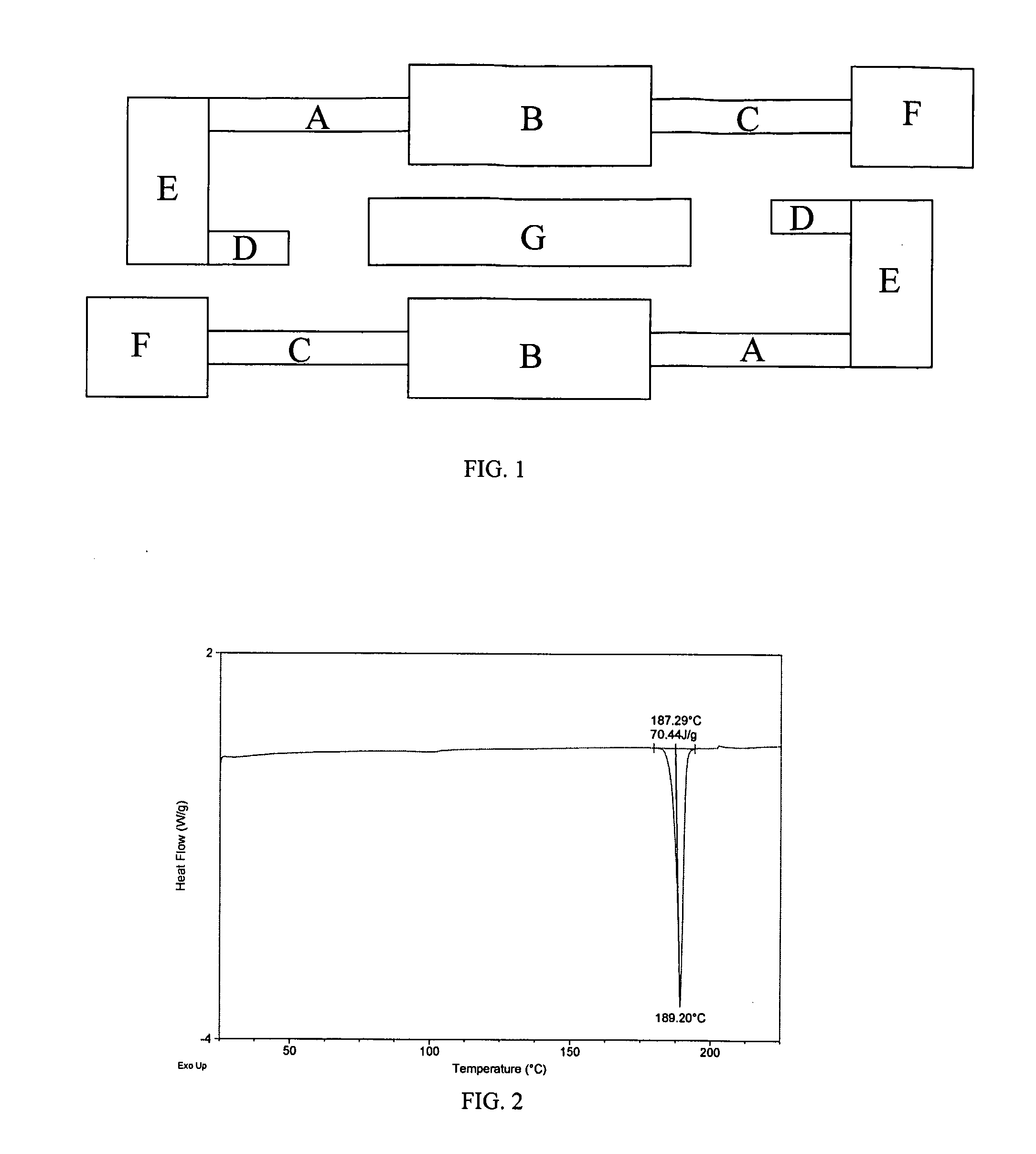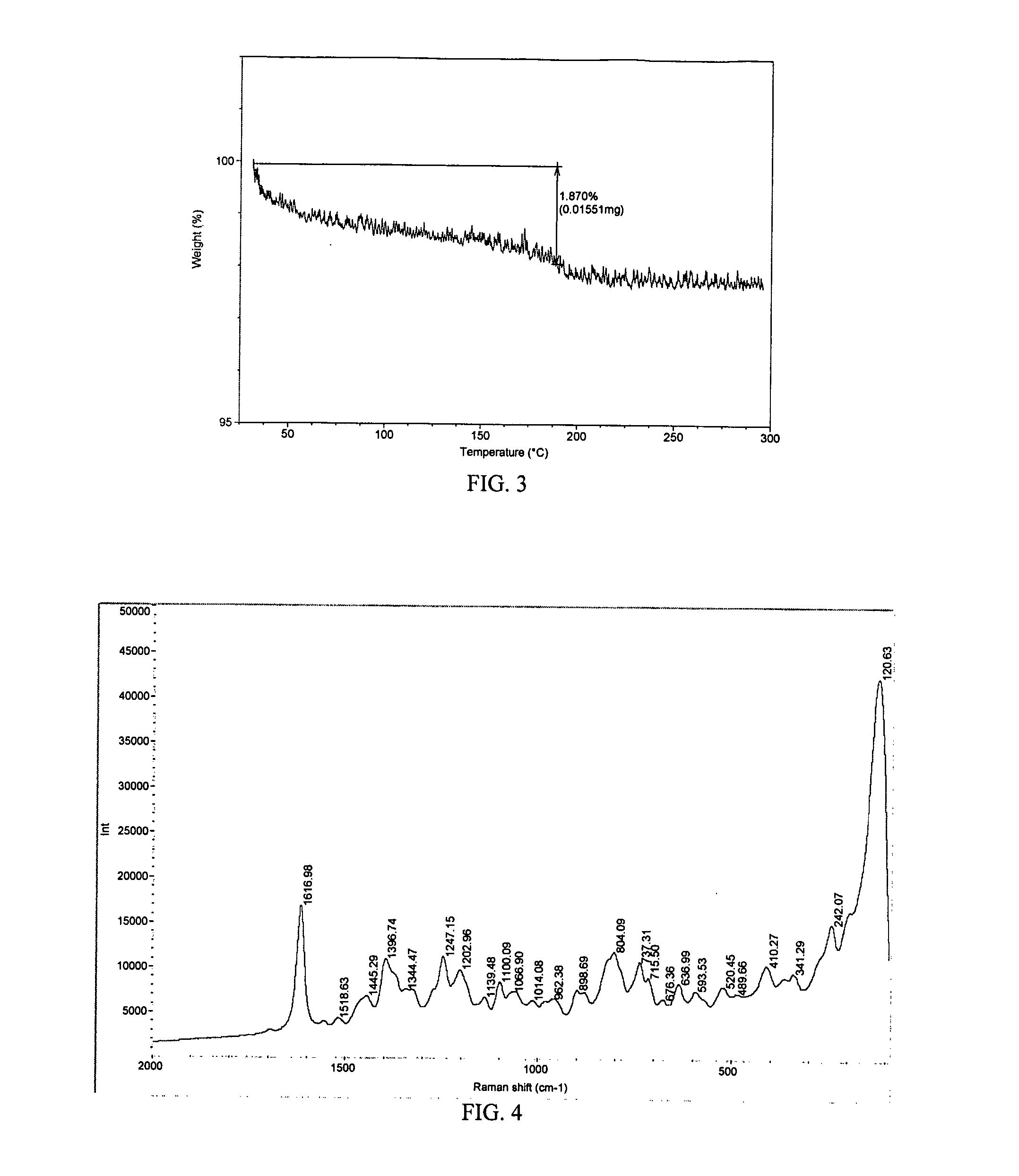Novel Saperconazole Crystalline Forms and Related Processes, Pharmaceutical Compositions and Methods
a technology of cisitraconazole and saperconazole, which is applied in the field of new soluble saperconazole and cisitraconazole crystalline forms, can solve the problems of affecting the treatment and affecting the treatment effect of patients with severe systemic fungal infections
- Summary
- Abstract
- Description
- Claims
- Application Information
AI Technical Summary
Benefits of technology
Problems solved by technology
Method used
Image
Examples
example 1
Sagerconazole
Comparative Data
[0259] Saperconazole was analyzed via DSC, TGA, Raman, and PXRD. (The preparation of saperconazole is described in U.S. Pat. No. 4,916,134.) The DSC thermogram showed an endothermic transition at about 189 degrees C. (See FIG. 2). The TGA thermogram showed about a 1.9 percent weight loss between about 30 and about 183 degrees C. (See FIG. 3). Saperconazole can be characterized by any one, any two, any three, any four, any five, or any six or more of the peaks in the Raman spectrum in FIG. 4 including, but not limited to, the peaks at about 1617, 1397, 1247, 1203, 1100, 899, 804, 737, 716, 410, and 341 cm−1. Saperconazole can be characterized by any one, any two, any three, any four, any five, or any six or more of the peaks in the PXRD diffractogram in FIG. 5 including, but not limited to, 3.05, 6.19, 8.21, 9.31, 10.95, 16.77, 17.75, 18.95, 19.27, 21.03, 21.85, 23.23, and 26.79 degrees 2-theta.
example 2
Saperconazole:DL-Tartaric Acid Co-Crystal
[0260] About 10 mg saperconazole and approximately 1 molar equivalent of DL-tartaric acid were dissolved in 200 microliters THF or 100 microliters 1,4-dioxane (dioxane) by heating at 75 degrees C. for approximately 2 hours. The solutions were cooled to 5 degrees C. and incubated until solid recrystallized. The solid was determined to be saperconazole:DL-tartaric acid co-crystal.
[0261] The saperconazole:DL-tartaric acid co-crystal was analyzed via DSC, TGA, and PXRD. The DSC thermogram showed an endothermic transition at about 185 degrees C. (See FIG. 6). The TGA thermogram showed about a 12.3 percent weight loss between about 175 and about 270 degrees C. (See FIG. 7). The saperconazole:DL-tartaric acid co-crystal can be characterized by any one, any two, any three, any four, any five, or any six or more of the peaks in the PXRD diffractogram in FIG. 8 including, but not limited to, 4.11, 6.27, 8.47, 14.69, 16.63, 18.33, 18.77, 20.01, 21.37,...
example 3
Saperconazole:Succinic Acid Co-Crystal
[0262] In a first synthesis, about 10 mg saperconazole and approximately 1 molar equivalent of succinic acid were dissolved in 200 microliters dioxane by heating at 75 degrees C. for approximately 2 hours. The solution was cooled to 5 degrees C. and incubated until solid crystallized and was then characterized. In a second synthesis, about 4 mg saperconazole and approximately 1 molar equivalent of succinic acid were dissolved in 100 microliters dioxane by heating the sample at approximately 70 degrees C., and immediately upon dissolution the solution was slowly cooled to 5 degrees C. The solution was incubated until very small needles crystallized. 100 microliters 1,2-dichloroethane were added, and the vial was held under warm running water to redissolve the solid. The solution was again incubated at 5 degrees C. until solid crystallized and was then characterized.
[0263] The resultant solid from the first synthesis, above, was analyzed via DSC...
PUM
| Property | Measurement | Unit |
|---|---|---|
| Angle | aaaaa | aaaaa |
| Angle | aaaaa | aaaaa |
| Angle | aaaaa | aaaaa |
Abstract
Description
Claims
Application Information
 Login to View More
Login to View More - Generate Ideas
- Intellectual Property
- Life Sciences
- Materials
- Tech Scout
- Unparalleled Data Quality
- Higher Quality Content
- 60% Fewer Hallucinations
Browse by: Latest US Patents, China's latest patents, Technical Efficacy Thesaurus, Application Domain, Technology Topic, Popular Technical Reports.
© 2025 PatSnap. All rights reserved.Legal|Privacy policy|Modern Slavery Act Transparency Statement|Sitemap|About US| Contact US: help@patsnap.com



